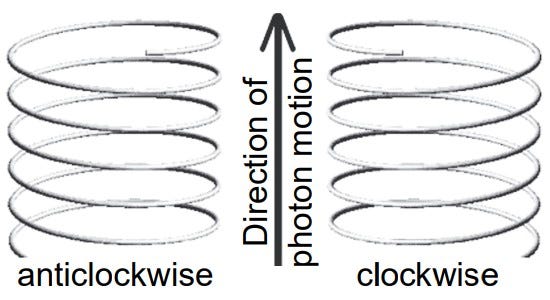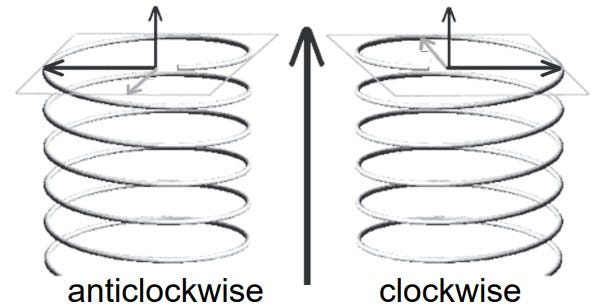[Posts are sequential, to be read/heard in date order - opposite to the order they’re generally displayed in. Paid-for posts have technical content.]
To hear an audio version of this post (22 mins 2 secs), click the arrow below:
Antimatter is one of the biggest unsolved scientific mysteries of our time - or one of the biggest clues, depending on how you choose to see it. From the spun-light perspective on material reality it’s more than just a clue - it’s a brilliant confirmation of this take on the fundamental nature of matter.
To put it in simple terms: if you have one major cosmic asymmetry - the imbalance between matter and antimatter - and another fundamental universal asymmetry (to be explained shortly) which could have a significant bearing on that imbalance, then you can be pretty certain that the two are connected.
More on this a little further down the line. Let’s look first at some of the facts, and the background to the whole antimatter story.
Antimatter as a serious concept came into being with a paper in 1928 by Paul Dirac, who five years later shared a Nobel prize with Erwin Schrödinger: Dirac’s relativistic version of Schrödinger’s wave equation for electrons led naturally to prediction of a positive-charge counterpart of the electron. These anti-electrons were detected in cosmic radiation four years later by Carl Andersen, who also received a Nobel prize for his discovery of what came to be called positrons.
Since then antimatter equivalents of protons with negative charge, antiprotons, have been created, and even whole antimatter atoms, antihydrogen, at quite prohibitive cost: in 2006, production of positrons was estimated to cost $250 million for 10 milligrams; in 1999, NASA gave a figure of $62.5 trillion per gram of antihydrogen.
Apart from the high cost of producing antimatter, taking significant time on some of the most expensive particle-accelerator hardware available, it’s extremely difficult to store it or hold onto it for any length of time. Antiparticles and normal-matter particles annihilate each other on contact, releasing the full energy content of each - that E = mc squared again. So antimatter even needs to be kept away from the sides of any container, using electric and magnetic fields - it’s tricky stuff! As an aside, if it could be conveniently produced and stored, it would make a very handy fuel - just 10 kilograms of antimatter, using that annihilation trick, could keep a normal car running for a million years non-stop.
So it’s not at all difficult to detect antimatter out there in space, even millions of light years away: if any gas or dust cloud of normal matter were to brush up against an outcrop of antimatter there would be a massive outpouring of MAD (mutual assured destruction) high-energy photons at the characteristic frequency for such an event - 511 kiloelectronvolts for electron-positron interaction - visible over vast distances. There is in fact a pocket of antimatter producing just such activity towards the centre of our galaxy, generally believed to be generated by LMXBs (low-mass X-ray binary star systems).
Various aspects of the antimatter saga are shrouded in mystery, notably the huge disparity between quantities of antimatter and normal matter in the observable universe. Dirac’s findings appear to indicate that there should have been equal proportions of the two produced in the immediate aftermath of the Big Bang, but the absence of major mutual annihilation events across the cosmos makes it clear that this isn’t the case. Just as well, since one-for-one destruction of particles and antiparticles would have left us with none of either - and so no material universe.
Early on it was suggested that matter/antimatter creation had been almost equal, with just the chance one-in-a-billion in favour of the sort we now have around us; those one-in-a-billion, after mutual annihilation of the rest, would have given us the stars and planets, and everything else, in the universe we know and love. However, this explanation doesn’t work, since this chance one-per-billion would have had to have operated in favour of normal stuff every time, for every particle in today’s universe. That’s the same sort of odds as tossing a coin a trillion trillion trillion trillion trillion trillion times - and have it come up heads every time. No chance.
In fact, even that one-in-a-billion doesn’t fit the observed facts. Professor Tara Shears is a member of the Beauty Project team at the LHC (Large Hadron Collider) investigating the imbalance in matter-antimatter abundance. At a presentation in September 2013 for The Royal Institution, she reported recent findings from the LHC on this topic.
Using the most extensive and most precise experimental data available, very reliable parameters have been defined for the Standard Model (of fundamental particle interactions) that allow detailed extrapolation back in time to the very beginning in respect of relative abundances of matter and antimatter .
The results of such extrapolation are, to use Tara Shears’ own words “a bit shocking”: far from finding an embryonic universe initially populated almost evenly with particles and antiparticles, the antimatter content amounts to “only one galaxy’s-worth” * according to Shears, who adds: “We’ve fallen short quite a lot!”. [* Of two trillion or more galaxies in the observable universe, according to findings from the Hubble Space Telescope.]
This is a far cry from the approximately 50/50 distribution proposed and expected by the conventional view, leaving, as Professor Shears says: “a lot of antimatter that’s unaccounted for”. However it's totally in accordance with the expected asymmetry in particle/antiparticle structure highlighted by the spun-light view of matter, as we’ll see very shortly.
The relationship between a matter particle and its antiparticle had, for a time, been thought to obey principles of CP symmetry: C stands for charge, equal and opposite in corresponding particles and their antiparticles; P stands for parity, effectively making an antiparticle a mirror image of its corresponding particle - think of left and right hands. So for every ‘right-handed’ normal matter particle, atom or molecular structure we could expect a corresponding ‘left-handed’ mirror-image antimatter particle, atom or molecular structure.
At first sight this would seem to fit well with our perception of matter particles being formed from combinations of right and left circularly polarised photons: it makes perfect sense that the corresponding antiparticle in each case would be formed from a directly opposite mix of left and right photon elements, giving both an equal and opposite charge and a mirror-image structure - CP symmetry. However, in 1964 CP violation was detected in the decay of particles known as kaons, earning Cronin and Fitch a Nobel prize for its discovery. Various other CP violations have since been found in relation to other particles.
Such violations were, of course, to be expected, since there has to be some reason for the dramatic difference in abundance of normal particles and their antiparticles, and this has to have its roots in some difference in the particles themselves. So the hunt is on to explain the underlying differences leading to these CP violations, since this could give insights into how the material universe was originally created.
If we look a little deeper into the photonic structure of matter, though, this spun-light perspective gives us a very clear insight into a fundamental structural difference between particles and their corresponding antiparticles, one that could well explain the dramatic dominance of the former over the latter.
Let’s start with a bit of gardening. Consider the issue of garden clippers …
A garden equipment manufacturer makes garden clippers. First off, of course, he starts by making right-handed clippers. As his business expands, he also starts making clippers for people who are left-handed.
But here he hits a slight snag…
He only has right-threaded screws to hold both types of clippers together. He finds that the right-handed pairs have a firm action and stay together well - but because of the opposite rotation, the left-handed pairs get loose and come apart much more quickly.
Ok, so what has all this got to do with antimatter?
We know that particles of matter are formed from photons of electromagnetic energy wrapped around on themselves. We know, too, that this energy comes in two polarisation states, Left and Right circular polarisation. We’ve figured that one of these gives rise to positive charge as an artefact of the particle structure, the other is responsible for negative charge; the overall net charge on a particle is the difference between these two elements in that structure, the difference between Right and Left circularly polarised components.
So it’s reasonable to expect that, if we replaced the Right circular components by Left circular components, and vice versa, we’d get a mirror image of that particle with an equal and opposite net charge - its antiparticle. We’d expect that antiparticle to have corresponding properties to the original particle, and a corresponding degree of durability.
Except that Right and Left circular polarisation states are not exact opposites - one is not an exact mirror image of the other; the detail’s in the small print.
Let’s look first at these two states from the point of view of their electric field rotation - the way in which they’re normally viewed. One is anticlockwise (Left circular) as viewed in the direction of the photon’s travel, the other is clockwise (Right circular) as viewed from the same perspective. From the diagram it’s quite apparent - apparently - that one is a direct mirror image of the other.
But now let’s add in the magnetic field component - after first considering the relative orientation of electric and magnetic fields in every electromagnetic wave. Every such wave consists of an electric and a magnetic field component oscillating at right angles to each other, and at right angles to the direction of motion of the photon. Think of a black yoyo going up and down and a grey yoyo going right and left (for this plane polarised wave) – both pushing each other along in the direction shown by the arrow.
With that in mind, let’s look again at those two polarisation states, side by side. This time we’ll include a snapshot of the magnetic field components together with the electric field components at one instant (top of each spiral) for comparison.
Here we see that, in accordance with Fleming’s Right-Hand Rule, the electric field component is 90 degrees clockwise from the magnetic field component in each case (looking down from the photon direction of motion in this case, to make it easier to see). From this simple diagram it’s abundantly clear that the magnetic field is not symmetric in these two polarisation states.
In my first journal paper on this subject I describe how, in the immediate aftermath of the Big Bang, every conceivable configuration of electric and magnetic field effects would have occurred in that unimaginably compact, unimaginably high-energy environment. Those closed-loop configurations which proved stable under that onslaught are the particles we see around us today, those that were unstable would have been wiped out in less than a nanosecond. That stability would have been on the basis of interaction of electric and magnetic fields: it’s totally thinkable that in the case of a highly stable elementary particle, such as an electron, a corresponding mirror-image particle could have arisen with the opposite polarisation of electromagnetic field effects - a positron; the structural integrity of that antiparticle could have been compromised by the magnetic-field component of its formative photon (or photons) being slightly differently oriented. So it would be that those antiparticle structures wouldn’t have been generated in such numbers, and/or would have disintegrated more readily in that high-energy environment.
And there we have the asymmetry of those garden clippers in miniature, replicated in the elementary subatomic particles of matter and antimatter at the very birth of the material universe. These two cosmic asymmetries, the matter-antimatter disparity and the disparity between the two types of photon energy forming matter itself, are too striking to be ignored. Just like those left-handed but right-threaded clippers, the ‘left-handed but right-threaded’ structure of antimatter particles offers a compelling reason for their vastly lower abundance compared with normal matter particles. It would surely be stretching the long arm of coincidence far too far to assume that these two cosmic asymmetries, so closely linked by the structure of matter itself, have nothing to do with each other.
On the contrary, that obvious structural connection offers a way into understanding of one of the biggest mysteries the cosmos has handed us - potentially one of the biggest clues to the origins of the material universe.
Yes, but what about time?
Various researchers have proposed that antimatter particles are normal particles moving backward through time. In fact, the original idea of CP (charge-parity) symmetry, having now been shown not to apply in all cases, has been replaced by CPT symmetry, in which matter and antimatter particles have been found to be symmetric under charge and parity reversal - plus a reversal in the direction of time.
Without needing to go into the detailed research, it’s very easy to confirm this idea in principle just by considering the situation we’ve been looking at. If we consider every thread of electromagnetic energy moving in the opposite direction in time, i.e. right-to-left in our wave diagram above rather than left-to-right, or downwards in our clockwise/anticlockwise diagrams rather than upwards, then we see straightaway that clockwise elements become anticlockwise and vice versa. At the same time magnetic field components 90 degrees ahead of the electric field components now become 90 degrees behind and vice versa. In other words all left-circular components become right-circular and vice versa, as well as the complete particle structure being the other way around: particles have become their corresponding antiparticles, antiparticles have become their matching particles.
This totally validates, and explains, the principle behind CPT symmetry. Another first for the spun-light understanding of matter.
====================================
Footnote 1 [ref for wave diagram]: For {W} read https://commons.wikimedia.org/wiki/ in the following. ‘Onde electromagnetique’ by SuperManu: {W}User:Emmanuel.boutet , from {W}File:Onde_electromagnetique.svg , derived from {W}File:Onde_electromagnetique.png by Cdang. Used under terms of Creative Commons Attribution-Share Alike 3.0 Unported license: https://creativecommons.org/licenses/by-sa/3.0/legalcode
====================================
Next up:
Quantum Randomness: Where did that come from??
The answer may surprise you.
In the meantime, be sure to check out Transfinite Mind for a wealth of free resources, including non-technical articles and presentations, as well as books to suit every level of scientific (or non-scientific) background.
Also, if you find these articles interesting and thought-provoking, and you know others who may find them of interest, please be sure to point those others in this direction. Thanks.







